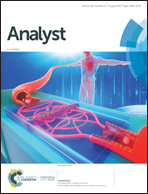Electrospun nanofiber supported optodes: scaling down the receptor layer thickness to nanometers – towards 2D optodes†
Abstract
A novel type of optode sensor is proposed using electrospun nanofibers as the supporting inert material. The proposed arrangement offers the possibility of a significant extension of the surface area of the probe while also minimizing the thickness of the receptor layer. This novel, close to 2D, optode configuration results in a sensor free from limitations related to analyte transport in the receptor phase. Unlike other formats, low analyte ion concentrations (10−8–10−5 M) were recorded, which are typically inaccessible for other formats of optodes, with a linear dependence of the emission signal on the logarithm of the analyte concentration. This effect results from a significant exhaustion of the analyte in the sample close to the interface with the sensor. On the other hand, as the ionophore surface concentration in the receptor was close to saturation, for a high concentration of the analyte (>10−5 M) in solution, the optode responses were observed with a sigmoidal dependence of the emission intensity on the logarithm of analyte concentration, independent of the applied ionophore contents in the 2D receptor phase. It was also shown that the response of the nanofiber supported liquid optode layer is reversible for the sigmoidal response range.



 Please wait while we load your content...
Please wait while we load your content...